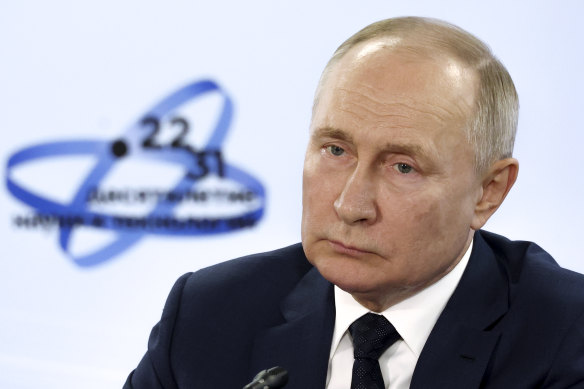
The ministers said they would work to make their supply chains more resilient, reliable, diversified and sustainable and respond to harmful practices, while safeguarding critical and emerging technologies.
“We will consider, when necessary, appropriate measures to promote de-risking and diversification of supply with partners within and beyond the G7.
“We will enhance co-operation to address non-market policies and practices and distortive policies, including those leading to overcapacity, through a wide range of policy tools and rules to ensure a global level playing field,” they said in the communiqué.

US Treasury Secretary Janet Yellen, European Central Bank president Christine Lagarde, Canada’s Finance Minister Chrystia Freeland, IMF head Kristalina Georgieva and UK finance chief Lindsey Whyte were among those in attendance.Credit: AP
The G7 is urging more work to be done on the macroeconomic effects of subsidies and industrial and trade policies, and plans talks with “third parties” on issues related to their industrial policies, economic fragmentation, market concentration and overcapacity.
While the G7 might be presenting a united front, views within Europe on how to respond to China aren’t quite as unified, largely because some European economies, most notably Germany’s, are more deeply enmeshed with China’s and perhaps because Europe is more vulnerable to retaliation than the US.
China has recently been signalling that it might impose a 25 per cent tariff of its own on imports of vehicles with large engines, which would impact German companies like BMW and Mercedes, while the potential to target imports of pork from Europe – about half the pork China imports comes from Europe, much of it from Spain – has been floated. There is already an anti-dumping investigation into imported brandy, which has unsettled France.
It’s not just China that has unnerved the Europeans. US trade policies are also increasingly distorting global trade and capital flows.

The G7 has made progress towards unfreezing Russia’s central bank assets held and frozen abroad.Credit: AP
The deeply protectionist response of the US to China, the massive subsidies inherent in Biden’s Inflation Reduction Act and the spectre of Donald Trump regaining the US presidency and following through with his plan to build a “universal” tariff wall around the US economy all encourage the Europeans to develop their own protectionist measures.
China’s targeting of key strategic industries for global dominance and the vulnerabilities inherent in over-reliance on one key supplier exposed by the pandemic almost ensured that decades of globalisation of trade would be wound back.
With the increased tensions between the West and China and the deepening China and Russia alliance, the outbreaks the combination of trade and security frictions threaten geopolitical and geoeconomic fragmentation, which isn’t helpful for global economic growth or stability.
While the unusually assertive targeting of China’s trade policies was a key message from the finance ministers’ summit, they also made progress towards tapping into Russia’s central bank assets held and frozen abroad.
The bulk of those assets are held within Europe, held by the Belgium-based clearing house Euroclear and it is those assets that have been the focus of much of the discussion about using Russia’s funds as aid to Ukraine.
The US and Ukraine have argued that all Russia’s frozen assets should be handed over to Ukraine but the Europeans and Western banks regard that as a step too far, one that would breach international laws that prohibit expropriation of foreign private assets without fair compensation.
The fact that the assets concerned belong to a central bank amplifies concerns that their seizure could impact the credibility of the euro and destabilise Euroclear, a key component of Europe’s financial system infrastructure. The Europeans are also more vulnerable than the US to retaliation from Russia, which has threatened to seize US and European assets held within Russia if its reserves are touched.
“Plan B” was to target only the interest being generated from the assets held by Euroclear of about €2.5 billion (about $4 billion) to €3 billion a year and handing those payments over to Ukraine.
Loading
The G7 is now working on a refinement to that concept, using that stream of interest payments over the next 20 years – or unless or until Russia pays Ukraine compensation for the damage it has done to Ukraine’s infrastructure and economy – as security for a $US50 billion ($75 billion) loan.
It is hoped that the detail of the plan, including how the exposure to the loan would be distributed among G7 members, can be put before a meeting of the G7 leadership, again in Italy, next month.
There’s a sense of urgency in devising a mechanism for securing a big lump of cash for Ukraine, not just because it is struggling against a fresh wave of assaults from Russia, but because the Europeans are concerned that a Trump presidency would see US support for Ukraine withdrawn.
The Biden administration and Ukraine are happy to take what’s now available and then rekindle the discussion about seizing the entirety of Russia’s offshore reserves for Ukraine once the $US50 billion has been secured.
The Business Briefing newsletter delivers major stories, exclusive coverage and expert opinion. Sign up to get it every weekday morning.



























